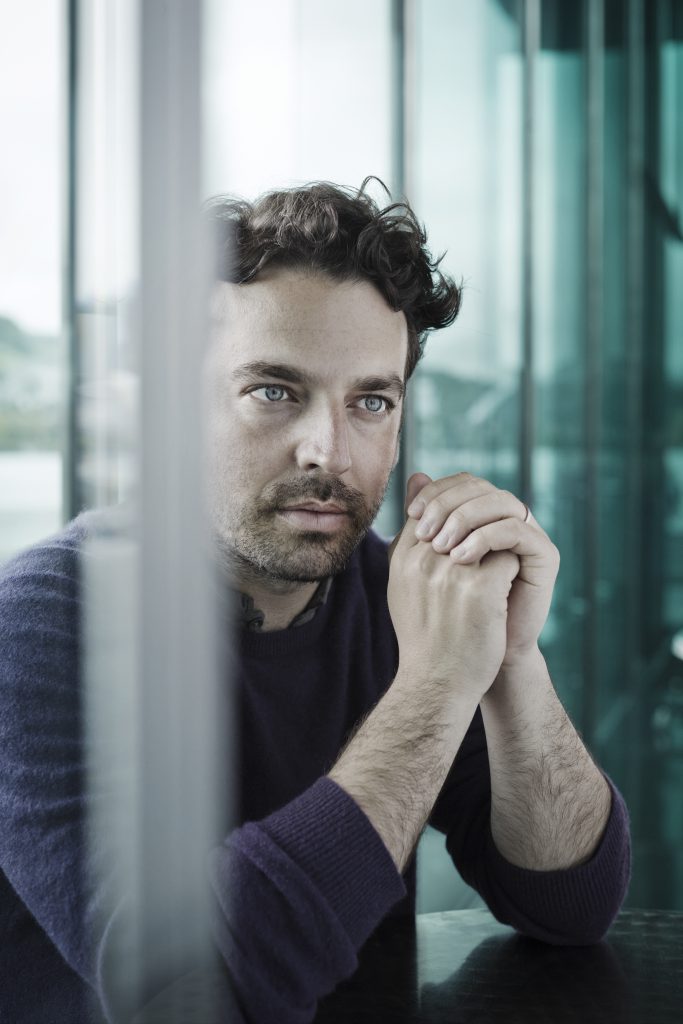Gaffigan, NSO and Trpčeski deliver a rousing Russian program

James Gaffigan conducted the National Symphony Orchestra Thursday night at the Kennedy Center.
The evening began quietly at the Kennedy Center Concert Hall Thursday night as conductor James Gaffigan took the podium to conduct the National Symphony Orchestra in an all-Russian program. The program was devoid of chestnuts, presumably a contributing factor behind the small audience, yet the concert was a gem.
Immediately after ascending the podium Gaffigan delivered an enthusiastic introduction of the night’s first selection, Prokofiev’s Third Symphony. With Halloween still in the air, Gaffigan emphasized Prokofiev’s evocation of “demonic possession” in the work (as the dividing of the first violins into three sections to imitate flying “spirits”). Gaffigan, chief conductor of the Lucerne Symphony Orchestra, summarized the composition as “pretty psychotic music, but it’s extraordinary.”
Much of the symphony draws on music from Prokofiev’s opera The Fiery Angel, which he considered one of his best creations, though it was never staged in in his lifetime. The symphony’s opening bars lived up to Gaffigan’s description—a positively scary, cacophonous chord of blaring brass and crashing bells.
After that the music became calmer, a balmy melody reflecting an amorous portion of the opera, with flutes providing a cloud-like background for the solo trumpet. The movement’s final theme, a jaunty march, ends with bassoons giving way to the contrabassoon, which has the last word with an extremely low note.
Gaffigan’s spirited reading and extremely clear beat produced fine playing from the NSO. Lines flowed seamlessly from strings to winds, highlighting Prokofiev’s ability to produce variegated effects.
The third movement’s divided first violins were indeed reminiscent of spirits darting across the stage. That effect gave way to yet more ethereal solo moments for the trumpet, with backing from strings and harps. The movement’s ending was memorable for its abruptly stopped brass climax.
Gaffigan’s promise of psychotic music was more than met in the raucous final movement, including four clangs on a church bell so towering that the percussionist had to climb several stairs to play it.
Shostakovich’s Piano Concerto No. 2 in F Major was the centerpiece and the highlight, with the Macedonian pianist Simon Trpčeski as soloist. Written as a graduation gift for the composer’s son Maxim in 1957, the concerto consists of a gorgeous Andante surrounded by a pair of spirited outer movements, both marked Allegro.
Displaying tremendous technique and a terrific sense of rhythm, Trpčeski was masterful, conveying immense joy in the opening movement’s galloping military march. Trpčeski avoided overplaying passages and Gaffigan and the NSO proved worthy collaborators.
Trpčeski’s light touch was notable in the Chopin-like Andante, with Gaffigan producing a beautiful sound from the NSO strings backing the soloist.
The Allegro followed with extremely long lines for the piano, which Trpčeski polished off with ease, warranting the loud standing ovation he received.
The evening ended with Khachaturian’s Masquerade Suite. This bit of Russian pop begins with a popular Waltz and ends with a comically dissonant Galop. Instead of adding syrup to the Waltz, Gaffigan’s approach was subdued, though his interpretation was far from dull. The Mazurka was beautifully blended, with the NSO sounding like a calliope at a carnival. Notable was solo playing from concertmaster Nurit Bar-Josef in the Nocturne and assistant principal trumpet Steve Hendrickson in the Romance.
The program will be repeated 8 p.m. Saturday. www.kennedy-center.org/nso
